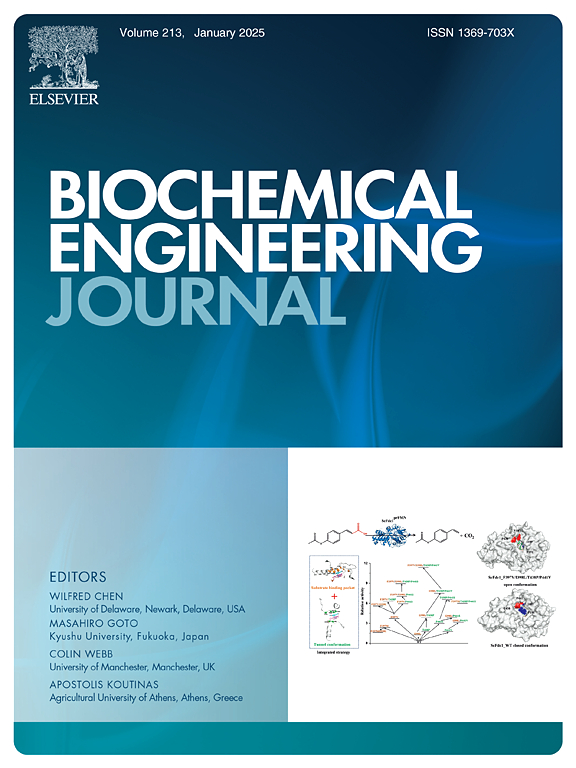Synthesis of (R)-acetoin by targeted immobilization of acetolactate synthase and acetolactate decarboxylase via the spy/snoop system
IF 3.7
3区 生物学
Q2 BIOTECHNOLOGY & APPLIED MICROBIOLOGY
引用次数: 0
Abstract
Acetoin (3-hydroxy-2-butanone) is an important four-carbon platform compound and an intermediate for several high-value-added pharmaceutical compounds. In this study, Catcher-Tag tagged proteins were used for targeted immobilization of acetolactate synthase (ALS) and acetolactate decarboxylase (ALDC) for catalyzing the synthesis of Acetoin from sodium pyruvate in vitro. The study discussed the enzymatic properties of the immobilized enzyme LX@ALS-SpyTag 和 LX@ALDC-SnoopTag, as well as the optimal catalytic conditions and reusability of the immobilized dual enzyme in vitro catalytic system. The immobilized enzyme exhibited higher relative activity across a broader range of temperature and pH intervals than the free enzyme. The in vitro catalytic synthesis of (R)-acetoin from sodium pyruvate using an immobilized dual enzyme system resulted in 99.95 % of the theoretical conversion of (R)-acetoin at 45°C, pH 7.0, and 0.2 M substrate concentration. In addition, the immobilized dual enzyme system had better operational stability than the free enzyme, retaining 69.20 % of the initial total catalytic activity after 5 cycles. In conclusion, this study demonstrated a promising and convenient Catcher-Tag tagged protein immobilization strategy that enables rapid targeted immobilization of tagged proteins directly from crude enzyme solution, providing a novel approach for the construction of in vitro immobilized multi-enzyme complexes.
spy/snoop系统固定化乙酰乳酸合酶和乙酰乳酸脱羧酶合成(R)-乙酰托因
乙托因(3-羟基-2-丁酮)是一种重要的四碳平台化合物,是几种高附加值药物化合物的中间体。本研究利用catch - tag标记的蛋白靶向固定化丙酮酸合酶(acetolactate synthase, ALS)和丙酮酸脱羧酶(acetolactate decarboxylase, ALDC),在体外催化丙酮酸钠合成acettoin。研究了固定化酶LX@ALS-SpyTag . LX@ALDC-SnoopTag的酶学性质,以及固定化双酶体外催化体系的最佳催化条件和可重复使用性。与游离酶相比,固定化酶在更宽的温度和pH区间内表现出更高的相对活性。在45℃、pH 7.0、0.2 M底物浓度条件下,固定化双酶体系催化丙酮酸钠合成(R)-乙酰托因的理论转化率为99.95 %。此外,固定化双酶体系比游离酶具有更好的操作稳定性,在5个循环后仍保持初始总催化活性的69.20 %。总之,本研究展示了一种有前景且方便的catch - tag标记蛋白固定化策略,可以直接从粗酶溶液中快速靶向固定化标记蛋白,为构建体外固定化多酶复合物提供了一种新的方法。
本文章由计算机程序翻译,如有差异,请以英文原文为准。
求助全文
约1分钟内获得全文
求助全文
来源期刊

Biochemical Engineering Journal
工程技术-工程:化工
CiteScore
7.10
自引率
5.10%
发文量
380
审稿时长
34 days
期刊介绍:
The Biochemical Engineering Journal aims to promote progress in the crucial chemical engineering aspects of the development of biological processes associated with everything from raw materials preparation to product recovery relevant to industries as diverse as medical/healthcare, industrial biotechnology, and environmental biotechnology.
The Journal welcomes full length original research papers, short communications, and review papers* in the following research fields:
Biocatalysis (enzyme or microbial) and biotransformations, including immobilized biocatalyst preparation and kinetics
Biosensors and Biodevices including biofabrication and novel fuel cell development
Bioseparations including scale-up and protein refolding/renaturation
Environmental Bioengineering including bioconversion, bioremediation, and microbial fuel cells
Bioreactor Systems including characterization, optimization and scale-up
Bioresources and Biorefinery Engineering including biomass conversion, biofuels, bioenergy, and optimization
Industrial Biotechnology including specialty chemicals, platform chemicals and neutraceuticals
Biomaterials and Tissue Engineering including bioartificial organs, cell encapsulation, and controlled release
Cell Culture Engineering (plant, animal or insect cells) including viral vectors, monoclonal antibodies, recombinant proteins, vaccines, and secondary metabolites
Cell Therapies and Stem Cells including pluripotent, mesenchymal and hematopoietic stem cells; immunotherapies; tissue-specific differentiation; and cryopreservation
Metabolic Engineering, Systems and Synthetic Biology including OMICS, bioinformatics, in silico biology, and metabolic flux analysis
Protein Engineering including enzyme engineering and directed evolution.
 求助内容:
求助内容: 应助结果提醒方式:
应助结果提醒方式:


